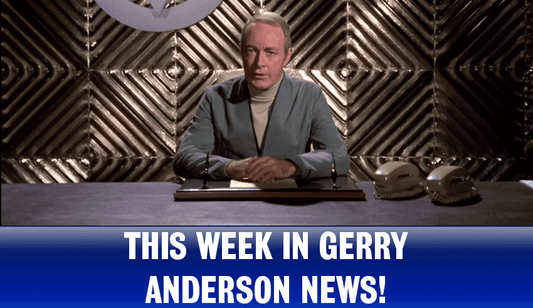Thunderbirds Thursday: Menace of the Martian Rock Snakes
Share
Share

Thunderbirds' first movie, Thunderbirds Are Go (1966), is jam-packed with an abundance of ground-breaking elements for the series: mankind's first journey to Mars, the possible death of the Hood, and one of the series' most confounding and horrifying alien creatures to ever be featured in a Gerry Anderson production. This Thunderbirds Thursday, we're venturing to the darker corners of the red planet to investigate the Martian Rock Snakes!
Life As We Don't Know It

The Martian Rock Snakes have a curious yet significant history in Thunderbirds. They can be considered to share the spotlight as the main antagonists of Thunderbirds Are Go, along with the Hood. The Rock Snakes may only appear in a secluded scene that has little impact on the rest of the movie, but it's a hugely memorable one. Having endured several setbacks, the colossal space exploration vessel Zero X has finally achieved planetfall on our neighbouring planet, Mars. Exploring the planet's seemingly barren surface, the Martian Exploration Vehicle, piloted by much of the Zero X crew, stumbles upon a series of strangely coiled rock formations.
On the orders of Zero X commander Captain Paul Travers, the MEV destroys one of these formations for the crew to collect samples for their return to Earth. However, this violent destruction stirs the other neighbouring formations into life. These deposits are, in fact, horrific alien creatures that proceed to awaken in their droves and attack the MEV. Barely escaping with their lives, the MEV crew manages to escape with the confirmation that life does indeed exist on Mars, but it's not life as we know it.
Quite appropriately, the Martian Rock Snakes are shrouded in mystery. Little appears to be documented as to the inspiration for their design or capabilities, other than they were devised by Gerry and Sylvia Anderson when writing the movie's script, and later fully designed by Derek Meddings. This lack of tangible detail only adds to their mythical quality. Alien beings had long been a staple of A.P. Films' output of puppet productions, but they'd nearly always subscribed to being at least humanoid in form and intelligence. With Thunderbirds Are Go, we're given a remarkably different portrayal of an alien menace.

The Martian Rock Snakes are much more like animals than people. There's a raw, primal immediacy to the threat they present: permanently hollowed-out mouths, a single, pupil-less, and bloodred eye, no protruding limbs, and fashioned entirely from Martian granite. Most deadly of all, they possess the ability to shoot liquid fire from their mouths. In terms of the pure visual terror that they embody, the Martian Rock Snakes have far more in common with something out of a Ray Harryhausen film than another Aquaphibian!
The entire sequence of the MEV's accidental destruction and ensuing escape from the Rock Snakes remains one of Thunderbirds Are Go's standout moments. The eerie, isolated setting and Barry Gray's lo-fi electronic soundtrack merging with the rumbling tractors of the MEV create a suitably otherworldly atmosphere. It's a definite throw-forward to the menace of Captain Scarlet in oppressive mood and visual style, and hardwires a horror motif into Thunderbirds Are Go's sci-fi grandeur.
Rock Snake Sensation

The Martian Rock Snakes evidently caught the imaginations of the editors, writers, and artists working on the sprawling array of comics, annuals, and other Gerry Anderson spin-off media throughout the late 1960s and early 1970s. Despite their minimal presence in Thunderbirds Are Go, these ferocious alien creatures made a variety of sporadic appearances in various non-TV publications.
The Martian Rock Snakes make an appearance in Zero X's debut TV21 storyline; Return to the Red Planet. Published between January and February 1967 and swiftly following on from Thunderbirds Are Go's December 1966 release, Return to the Red Planet is a curious retread of the Mars-set sequence from the film with little variety. In this instance, however, we at least get to see Paul Travers come almost face-to-face with the Rock Snakes themselves. The Zero X crew would grapple with the Rock Snakes a third and final time in the 1968 TV21 annual in the standalone story Conflict on Mars. Illustrated by Ron Turner, this brief adventure sees the Zero X crew forced to rescue enemy Bereznik agents when they attempt to make contact with the planet themselves, but are attacked by the snakes.

The Rock Snakes make a further appearance in the joint Captain Scarlet/Thunderbirds annual. In an elaborate three-page spread detailing the history of Mars, an illustrated map shows that the Rock Snake belt region is situated in close proximity to the Mysterons' Complex, which itself is described as a forbidden area. Intriguingly, a possible origin story for the Rock Snakes occurs within the pages of TV21. During a Secret Agent 21 storyline from 1969, space spy of the future, Brent Cleever, AKA Agent 21, embarks on an expedition to burrow into the centre of Mars. During his adventures, Cleever and his expedition party encounter a mutated Rock Snake, along with an ancient underground civilisation. It transpires that the Rock Snakes were, in fact, created by this aged civilisation, produced to be their metal guardians.
In this obscure storyline, the Rock Snakes are portrayed as having arm-like limbs and that their rocky exteriors are in fact built around mechanical exoskeletons. However you may want to accept this as a definitive origin may depend on how far you accept spin-off media as legitimate canon. Nevertheless, this odd suggestion as to the Rock Snakes' true background serves as an eye-opening reminder as to how TV21 often filled in these world-building details where the TV series and films would leave them blank.
Countdown to the Rock Snakes
After these middling appearances, the Rock Snakes found themselves thrust back into the spotlight in the pages of Countdown. In Captain Scarlet's final original storyline from issue #32, The Return of the Rock Snakes, the Mysterons capture a mass of dormant Rock Snakes so that Captain Black, aided by a small army of fellow Mysteron operatives, can transport them to Earth and unleash them throughout various military installations. However, Colonel White soon unravels the Mysterons' true intentions: with the Earth's defences preoccupied, more Rock Snakes can be used to attack the Centre for Bacterial Survey and Development, triggering an unstoppable plague across the Earth. The story climaxes with a violently surreal yet memorable showdown between Captain Scarlet and the offending Rock Snake!
The Rock Snakes would lay dormant for nearly 50 years before making an unexpected return for Fireball XL5's 60th anniversary. In the unique standalone storyline, Interplanetary Rescue, originally published in the Fireball XL5 Comic Anthology, the Rock Snakes' connections to the Mysterons continue to run deeper and in more unexpected ways than you may think!

It's a comical irony that the Rock Snakes should have such a strong association with the world of Thunderbirds despite never having actually grappled with the Thunderbirds themselves. It does rather feel like a missed opportunity not to have International Rescue square off against the Rock Snakes in some fashion. Still, the Martian Rock Snakes remain one of the most unusual and terrifying alien creations from the world of Thunderbirds, and their afterlife offers many intriguing connective threads between other Anderson heroes.
To be the first to hear about the latest news, exclusive releases and show announcements, sign up to the Anderson Entertainment newsletter!




![Fireball XL5 World Space Patrol Technical Operations Manual [HARDCOVER BOOK] - The Gerry Anderson Store](http://gerryanderson.com/cdn/shop/files/fireball-xl5-world-space-patrol-technical-operations-manual-hardcover-book-290050.jpg?v=1711729272&width=720)



![Stingray Comic Anthology Volume Two – Battle Lines [HARDCOVER] - The Gerry Anderson Store](http://gerryanderson.com/cdn/shop/files/stingray-comic-anthology-volume-two-battle-lines-hardcover-107681.jpg?v=1738856151&width=720)
![Space: 1999 and UFO Book Bundle - Signed Limited Editions [HARDCOVER NOVELS] - The Gerry Anderson Store](http://gerryanderson.com/cdn/shop/files/space-1999-and-ufo-book-bundle-signed-limited-editions-hardcover-novels-589446.jpg?v=1718836845&width=720)
![Stingray WASP Technical Operations Manual Special Limited Edition [HARDCOVER BOOK] - The Gerry Anderson Store](http://gerryanderson.com/cdn/shop/files/stingray-wasp-technical-operations-manual-special-limited-edition-hardcover-book-991914.jpg?v=1732922875&width=720)
![Stingray: The Titanican Stratagem – Signed Limited Edition [HARDCOVER NOVEL] - The Gerry Anderson Store](http://gerryanderson.com/cdn/shop/files/stingray-the-titanican-stratagem-signed-limited-edition-hardcover-novel-129251.jpg?v=1740558711&width=720)






